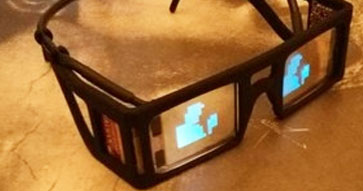To be blind is not miserable; not to be able to bear blindness, that is miserable.
It’s long been known that blind people are able to compensate for their loss of sight by using other senses, relying on sound and touch to help them “see” the world. Neuroimaging studies have backed this up, showing that in blind people brain regions devoted to sight become rewired to process touch and sound as visual information.
New inventions to help the visually-impaired have evolved in leaps and bounds.
Now, the bar has been raised further. The focus is now on assistive tools that allow the visually impaired to ‘see’, instead of just helping them feel the world around.
Here are six such innovative technologies:
eSIGHT 3

In the absence of a medical solution for people who are legally blind, eSight 3 (Electronic Glasses for the Legally Blind) helps restore eyesight for those who have lived without it for years, decades, and in some cases, entire lifetimes.
The headsets transmit images from a forward-facing camera to small internal screens in a way that beams the video into the wearer’s peripheral vision.
Although eSight’s glasses won’t help people with total blindness, they could still be a huge deal for the millions of people with visual impairment.
Eye Music

In simple words, this technology allows people to perceive colour and shape through music.
A woman, who has been blind since birth, is asked to identify a bottle of cold drink from among three of them without knowing where exactly they’re kept, and she correctly does so with the help of the device.
The EyeMusic app constructs a “soundscape” that conveys visual information through musical notes. The musical cues – which combine into a pleasant tune – let them know the colour, shape, and location of objects.
With training to extract meaning from patterns of notes, the blind can learn to read, tell what they are looking at from far away, and even recognise facial expressions and body postures.
ARGUS II

The FDA-approved Argus II – Retinal Prosthesis System has given people with complete blindness a basic form of sight, and in some cases, even helped them read.
The device includes a bionic retinal implant for the eyes. It takes over the redundant retina’s role of generating electrical signals after receiving information from a camera. The implant then sends pulses down the optical nerve that the brain can learn to interpret as vision.
It needs an optic nerve to work, so this excludes the people who are blind because a severed optic nerve.
Assisted Vision Smart Glasses

These smart glasses display the world in outlines for the blind and allow them to ‘see’ movement and even facial expression.
It consists of video camera mounted on the frame of the glasses, a computer processing unit that is small enough to fit in a pocket and software that provides images of objects close-by on the see-through displays in the eyepieces of the glasses.
Anyone using the glasses looks through them to make the most of their existing sight, with additional images appearing in their line of sight to give extra information about who or what is in front of them.
While they cannot be used by people who can see nothing at all, they are designed for those who are ‘severely sight impaired‘ and classified as blind. The glasses don’t replace lost vision, but assist with spatial awareness.
BRAINPORT V100

A device to help the visually impaired “see with their tongues,” the BrainPort V100 uses a camera attached to a pair of glasses to convert the images into electrical signals.
One part of the device is placed in the person’s mouth, and they receive the signal through their tongue. The user is trained to read the signals; like Braille for the tongue.
This device does not replace a cane or a guide dog. It is designed to improve spatial awareness, object recognition and assist in mobility.
Most of the users who tried the device said it helped them gain some sort of visual semblance about the physical world around them.
These technological advancements raise the possibility not only for these temporary sensory stand-ins, but also for potential permanent treatment options, circumventing the malfunctioning perceptual organ and accessing sensory regions in the brain that had previously been thought to lie dormant.
Technology has changed the world and gave the new directions to those who are in need.